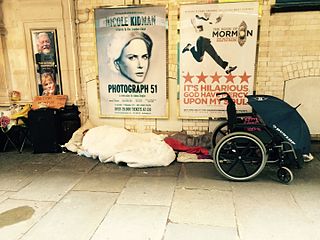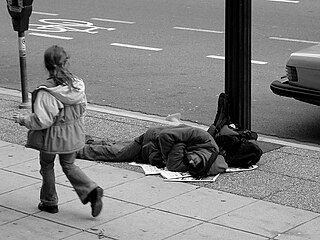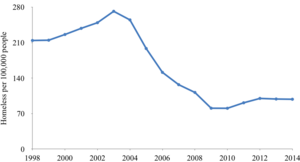
Shelter is a registered charity that campaigns for tenant rights in Great Britain. It gives advice, information and advocacy to people and lobbies government and local authorities for new laws and policies. It works in partnership with Shelter Cymru in Wales and the Housing Rights Service in Northern Ireland. The charity was founded in 1966 and raised 48.2 million pounds in 2020/21.
Housing Benefit is a means-tested social security benefit in the United Kingdom that is intended to help meet housing costs for rented accommodation. It is the second biggest item in the Department for Work and Pensions' budget after the state pension, totalling £23.8 billion in 2013–14.
The Rough Sleepers Initiative was an initiative by the Government of the United Kingdom's Rough Sleepers Unit (RSU), which resulted from a campaign by St Mungo's, a London homelessness charity, called National Sleep Out Week. It was designed to accommodate homeless people with emergency hostels.
Catching Lives is a charity based in Canterbury, England that assists rough sleepers, the homeless and those in insecure housing. It relies on donations, volunteers and fundraising within its local community. As of 2011, Archbishop of Canterbury Rowan Williams was patron.

Homelessness in Australia is a social issue concerning the number of people in Australia that are considered to be homeless. There are no internationally agreed upon definitions of homelessness, making it difficult to compare levels of homelessness across countries. A majority of people experiencing homelessness long-term in Australia are found in the large cities of Sydney, Melbourne, Brisbane and Perth. It is estimated that on any given night approximately 116,000 people will be homeless and many more are living in insecure housing, "one step away from being homeless". A person who does not obtain any shelter is often described as sleeping 'rough'.
Thames Reach is a London-based charity working with those suffering from homelessness.

Homelessness in the United Kingdom is measured and responded to in differing ways in England, Scotland, Wales and Northern Ireland, but affects people living in every part of the UK's constituent countries. Most homeless people have at least a modicum of shelter but without any security of tenure. Unsheltered people, "rough sleepers", are a small minority of homeless people.

Homelessness in Scotland is considered a serious social issue. Since the Scottish devolution from the United Kingdom in 1999 and the reconvening of the Scottish Parliament homeless legislation and policy in Scotland has diverged in important ways from the rest of the UK.

Homelessness or houselessness – also known as a state of being unhoused or unsheltered – is the condition of lacking stable, safe, and functional housing. The general category includes disparate situations, including:

Anti-homelessness legislation can take two forms: legislation that aims to help and re-house homeless people; and legislation that is intended to send homeless people to homeless shelters compulsorily, or to criminalize homelessness and begging.
Crisis accommodation is housing provided to people experiencing temporary or ongoing conditions of mental or physical health challenges. It aims to remove them from an otherwise harmful environment and allowing them to improve their situations from a safe and stable environment. Situations that may be alleviated through crisis accommodation include but are not limited to homelessness, domestic violence, elder abuse, and child abuse. Crisis accommodation is typically provided through government organisations, not-for-profit organisations and charities. Crisis accommodation is also known as housing subsidies in other words. Crisis accommodation is provided everywhere around the world across various countries. There are other factors such as availability of the services and reasons like poverty and accumulation of debt that affect homelessness which needs to be taken into account in order to solve it as more people tend to look for urgent support when they are facing this crisis.

Louise Casey, Baroness Casey of Blackstock,, is a British government official working in social welfare.

The St Mungo Community Housing Association, working as St Mungo's, is a charity registered in England to help homeless people.
Gatekeeping is a term in British housing law which describes when a Council refuses to accept a homelessness application and/or provide accommodation when they have a legal duty to do so. Pressure for Councils to engage in "gatekeeping" can be the result of the high cost of providing temporary accommodation or there simply not being enough housing within a borough to accommodate homeless applicants. Gatekeeping practices of some local authorities have been challenged by judicial review.
Homelessness in New Zealand has been linked to the general issue of lack of suitable housing. The homeless population is generally measured through the country's census and by universities and other academic centres. In 2009, urban homelessness were estimated at less than 300, while rural homelessness was estimated between 500 and 1000. An additional 8,000–20,000 live in "temporary accommodation unsuited for long-term habitation ." Homelessness in New Zealand has traditionally been reduced by the provision of state housing, similar to Germany and other developed countries.
Austerity measures and the ongoing fiscal crisis have significantly spurred the rise in homelessness in Greece in the 21st century. Instances of homelessness have been dominantly concentrated in the city of Athens. Homelessness remains a relatively under-examined area of social policy in Greece, with the first organised counting for homeless people taking place in May 2018. Governments and non-profit organisations alike have made efforts to counter this phenomenon.
Homelessness in France is a significant social issue that is estimated to affect around 300,000 people - a figure that has doubled since 2012 (141,500) and tripled since 2001 (93,000). Around 185,000 people are currently staying in shelters, some 100,000 are in temporary housing for people seeking asylum and 16,000 live in slums.
The number of people living in dangerous and subpar housing has significantly expanded as a result of the economic and financial crisis. The issue at hand no longer solely affects one nation in the world. The majority of nations are attempting to solve this issue in some form. Because of increased unemployment and declining wages, more people are unable to afford housing costs, increasing their risk of being homeless. Spain, which suffered greatly from COVID-19 and the accompanying economic downturn, is likewise grappling with a huge rural population decline problem. Homelessness is a serious socioeconomic issue that affects 40,000 people in Spain. Immigrants make up a disproportionate number of the homeless population. There are a lot of young people who are homeless; according to some estimates, 30% of Spain's homeless are between the ages of 18 and 29. Just 5% of the country's population, according to Spain's Research Institute for Depopulation and Development of Rural Areas, resides there. Homelessness and public begging are not officially forbidden under Spanish law.
The Homeless Foundation is a registered charity based in the West Midlands with the aim of eradicating homelessness across the United Kingdom. It was founded in 2007 and is run by a board of trustees.
The Whitechapel Centre is a homeless day-centre and registered charity in Langsdale Street, Liverpool, England. Established in 1975, it works with people in the Liverpool and Sefton areas, offering advice and information about housing. The centre is open 12 hours a day for 365 days a year. From 2018 until the COVID-19 pandemic in March 2020, the Whitechapel Centre also offered a night shelter, Labre House.










